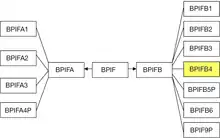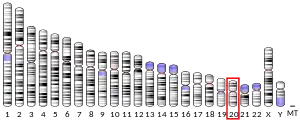| BPIFB4 | |||||||||||||||||||||||||||||||||||||||||||||||||||
|---|---|---|---|---|---|---|---|---|---|---|---|---|---|---|---|---|---|---|---|---|---|---|---|---|---|---|---|---|---|---|---|---|---|---|---|---|---|---|---|---|---|---|---|---|---|---|---|---|---|---|---|
| Identifiers | |||||||||||||||||||||||||||||||||||||||||||||||||||
| Aliases | BPIFB4, C20orf186, LPLUNC4, RY2G5, dJ726C3.5, BPI fold containing family B member 4 | ||||||||||||||||||||||||||||||||||||||||||||||||||
| External IDs | OMIM: 615718 MGI: 2685852 HomoloGene: 66971 GeneCards: BPIFB4 | ||||||||||||||||||||||||||||||||||||||||||||||||||
| |||||||||||||||||||||||||||||||||||||||||||||||||||
| |||||||||||||||||||||||||||||||||||||||||||||||||||
| |||||||||||||||||||||||||||||||||||||||||||||||||||
| |||||||||||||||||||||||||||||||||||||||||||||||||||
| Wikidata | |||||||||||||||||||||||||||||||||||||||||||||||||||
| |||||||||||||||||||||||||||||||||||||||||||||||||||
BPI fold containing family B, member 4 (BPIFB4) is a protein that in humans is encoded by the BPIFB4 gene.[5] It was formerly known as "Long palate, lung and nasal epithelium carcinoma-associated protein 4" encoded by the LPLUNC4 gene. The BPIFB4 gene sequence predicts 4 transcripts (splice variants); 3 isoforms have been well characterized.[6][7] In a variety of mammals, BPIFB4 is generally expressed in very high levels in the olfactory epithelium (nasal mucosa), high levels in the gonads (testis, ovary) and pituitary, moderate levels in white blood cells (monocytes)[8][9][10][11] It can occur either localized in the cytoplasm of cells or secreted and circulated systemically in blood plasma.
Superfamily
BPIFB4 is a member of a BPI fold protein superfamily defined by the presence of the bactericidal/permeability-increasing protein fold (BPI fold) which is formed by two similar domains in a "boomerang" shape.[12] This superfamily is also known as the BPI/LBP/PLUNC family or the BPI/LPB/CETP family.[13] The BPI fold creates apolar binding pockets that can interact with hydrophobic and amphipathic molecules, such as the acyl carbon chains of lipopolysaccharide found on Gram-negative bacteria, but members of this family may have many other functions.

Genes for the BPI/LBP/PLUNC superfamily are found in all vertebrate species, including distant homologs in non-vertebrate species such as insects, mollusks, and roundworms.[14][15] Within that broad grouping is the BPIF gene family whose members encode the BPI fold structural motif and are found clustered on a single chromosome, e.g., Chromosome 20 in humans, Chromosome 2 in mouse, Chromosome 3 in rat, Chromosome 17 in pig, Chromosome 13 in cow. The BPIF gene family is split into two groupings, BPIFA and BPIFB. In humans, BIPFA consists of 3 protein encoding genes BPIFA1, BPIFA2, BPIFA3, and 1 pseudogene BPIFA4P; while BPIFB consists of 5 protein encoding genes BPIFB1, BPIFB2, BPIFB3, BPIFB4, BPIFB6 and 2 pseudogenes BPIFB5P, BPIFB9P. What appears as pseudogenes in humans may appear as fully functional genes in other species.
BPIFB4 occurs as 3 separate isoforms in humans.[7] These isoforms were discovered in a genome-wide association study of centenarians that revealed 3 haplotypes of the BPIFB4 gene: wild-type (WT-BPIFB4), a longevity-associated variant (LAV-BPIFB4) with a 29% allele frequency, and a rare variant (RV-BPIFB4) with a 5% allele frequency.[16] The BPIFB4 gene is found with other members of the BPIF gene family in a cluster on chromosome 20 in humans.
Function
BPIFB4 protein is normally expressed in olfactory epithelium, mononuclear cells and macrophage-like cells as well as a variety of progenitor/stem cell types.[17] In the olfactory mucosa it is believed to act similarly to other BPIFB proteins in the innate immune response to bacterial exposure. BPIFB4 found circulating in the bloodstream is believed to interact with endothelial cells lining blood vessels which subsequently results in a vasorelaxation of the smooth muscle cells of blood vessels.
Longevity-associated variant LAV-BPIFB4
The study of many populations of centenarians made it possible to identify the longevity-associated variant (LAV) of the BPIFB4 gene. In individuals with high circulating levels of LAV-BPIFB4, it appears to be cardioprotective[17][18] and immunodulatory (anti-inflammatory).[19] In a study of long-living individuals (LLI), the circulating plasma levels of PBIB4 protein was compared between middle aged individuals (45-59 years old), healthy LLI (95-97 years old), and frail LLI (96-99 year old). Circulating BPIB4 was much higher in the healthy LLI group (824 pg/mL) compared to middle aged controls (133 pg/mL) and the frail LLI group (21 pg/mL).[20]
LAV-BPIFB4 is believed to be cardioprotective due to overall improved endothelial cell function, lowering blood pressure and improving revascularization when cardiac tissue may be compromised.[18] The mechanism for that is suggested by experimental forced expression of LAV-BPIFB4 by gene transfer in old mice and in an animal model of hypertension; elevated LAV-BPIFB4 causes reduced blood pressure which rescued age-related endothelial dysfunction in part by endothelial nitric oxide synthase (eNOS) activation.[16] This effect arises from a cascade of biochemical events. WT-BPIFB4 and LAV-BPIFB4 have different subcellular localization; WT-BPIFB4 localizes to the cell nucleus while LAV-BPIFB4 is cytoplasmic.[7] LAV-BPIFB4 in the endoplasmic reticulum (ER) is phosphorylated by Protein Kinase R (PKR) which results in enhanced protein unfolding, reduced ER stress, and overall improved cellular homeostasis. In addition to phosphorylation by PKR, LAV-BPIFB4 can be phosphorylated by Protein Kinase C alpha. In either case, when LAV-BPIFB4 becomes phosphorylated in the cytosol, it can then interact with 14-3-3 protein and Heat Shock Protein 90, forming a complex. This complex, in turn, activates eNOS. Activated eNOS produces nitric oxide which causes vasorelaxation of smooth muscle cells in blood vessels throughout the circulatory system, lowering blood pressure. Furthermore, increased nitric oxide from activated eNOS promotes the sprouting of new capillaries (angiogenesis) in conditions when ischemia occurs[21] caused by the blockage of arteries by atherosclerosis, for example.
LAV-BPIFB4 is believed to be immunomodulatory due to a variety of mechanisms involving macrophages and monocytes that can counteract low-grade chronic inflammatory conditions.[19] BPIFB4 induces a M2 macrophage polarizing effect which helps resolve inflammation, help tissue healing, and tolerate self-antigens. BPIFB4 induces a redistribution of circulating monocytes from classical monocytes (CD14++CD16-) to non-classical monocytes (CD14++CD16++), normally elevated in patients with coronary artery disease but in this case thought to patrol the vasculature and remove damaged cells in several disease conditions, thereby aiding tissue healing. BPIFB4 also reduces T-cell activation demonstrated by suppression of T cell proliferation and elevation of circulating levels of interleukins IL-23, IL-27 and atheroprotective IL-33.[22]
As a gene variant associated with exceptional longevity, capable to protect from hypertension, atherosclerosis, diabetic cardiopathy, frailty, and inflammaging, LAV-BPIFB4 gene is a promising candidate new ‘drug’ to treat atherosclerosis, its cardiovascular complications, and neurodegenerative diseases.[17]
References
- 1 2 3 GRCh38: Ensembl release 89: ENSG00000186191 - Ensembl, May 2017
- 1 2 3 GRCm38: Ensembl release 89: ENSMUSG00000074665 - Ensembl, May 2017
- ↑ "Human PubMed Reference:". National Center for Biotechnology Information, U.S. National Library of Medicine.
- ↑ "Mouse PubMed Reference:". National Center for Biotechnology Information, U.S. National Library of Medicine.
- ↑ "Entrez Gene: BPI fold containing family B, member 4".
- ↑ "Gene: BPIFB4 (ENSG00000186191) - Summary - Homo_sapiens - Ensembl genome browser 109". useast.ensembl.org. Retrieved 15 February 2023.
- 1 2 3 Villa F, Carrizzo A, Ferrario A, Maciag A, Cattaneo M, Spinelli CC, et al. (October 2018). "A Model of Evolutionary Selection: The Cardiovascular Protective Function of the Longevity Associated Variant of BPIFB4". International Journal of Molecular Sciences. 19 (10): 3229. doi:10.3390/ijms19103229. PMC 6214030. PMID 30347645.
- ↑ "Gene : BPIFB4 - ENSSSCG00000029295". bgee.org. The Bgee suite: integrated curated expression atlas and comparative transcriptomics in animals. Retrieved 15 February 2023.
- ↑ "Gene : Bpifb4 - ENSMUSG00000074665". bgee.org. The Bgee suite: integrated curated expression atlas and comparative transcriptomics in animals. Retrieved 15 February 2023.
- ↑ "Gene : BPIFB4 - ENSG00000186191". bgee.org. The Bgee suite: integrated curated expression atlas and comparative transcriptomics in animals. Retrieved 15 February 2023.
- ↑ "Gene : BPIFB4 - ENSBTAG00000038412". bgee.org. The Bgee suite: integrated curated expression atlas and comparative transcriptomics in animals. Retrieved 15 February 2023.
- ↑ Beamer LJ, Carroll SF, Eisenberg D (April 1998). "The BPI/LBP family of proteins: a structural analysis of conserved regions". Protein Science. 7 (4): 906–914. doi:10.1002/pro.5560070408. PMC 2143972. PMID 9568897.
- ↑ "CDD Conserved Protein Domain Family: BPI". www.ncbi.nlm.nih.gov.
- ↑ Beamer LJ, Fischer D, Eisenberg D (July 1998). "Detecting distant relatives of mammalian LPS-binding and lipid transport proteins". Protein Science. 7 (7): 1643–1646. doi:10.1002/pro.5560070721. PMC 2144061. PMID 9684900.
- ↑ Bingle CD, Seal RL, Craven CJ (August 2011). "Systematic nomenclature for the PLUNC/PSP/BSP30/SMGB proteins as a subfamily of the BPI fold-containing superfamily". Biochemical Society Transactions. 39 (4): 977–983. doi:10.1042/BST0390977. PMC 3196848. PMID 21787333.
- 1 2 Villa F, Carrizzo A, Spinelli CC, Ferrario A, Malovini A, Maciąg A, et al. (July 2015). "Genetic Analysis Reveals a Longevity-Associated Protein Modulating Endothelial Function and Angiogenesis". Circulation Research. 117 (4): 333–345. doi:10.1161/CIRCRESAHA.117.305875. PMC 5496930. PMID 26034043.
- 1 2 3 Dossena M, Ferrario A, Lopardo V, Ciaglia E, Puca AA (September 2020). "New Insights for BPIFB4 in Cardiovascular Therapy". International Journal of Molecular Sciences. 21 (19): 7163. doi:10.3390/ijms21197163. PMC 7583974. PMID 32998388.
- 1 2 Cattaneo M, Beltrami AP, Thomas AC, Spinetti G, Alvino V, et al. (13 January 2023). "The longevity-associated BPIFB4 gene supports cardiac function and vascularization in aging cardiomyopathy". Cardiovascular Research. 119 (7): 1583–1595. doi:10.1093/cvr/cvad008. PMC 10318395. PMID 36635236.
- 1 2 Montella F, Lopardo V, Cattaneo M, Carrizzo A, Vecchione C, et al. (2021). "The Role of BPIFB4 in Immune System and Cardiovascular Disease: The Lesson from Centenarians". Translational Medicine UniSa. 24 (1): 1–12. doi:10.37825/2239-9747.1024. PMC 9673912. PMID 36447743. S2CID 247121105.
- ↑ Villa F, Malovini A, Carrizzo A, Spinelli CC, Ferrario A, et al. (December 2015). "Serum BPIFB4 levels classify health status in long-living individuals". Immunity & Ageing. 12 (1): 27. doi:10.1186/s12979-015-0054-8. PMC 4678610. PMID 26675039.
- ↑ Luque Contreras D, Vargas Robles H, Romo E, Rios A, Escalante B (November 2006). "The role of nitric oxide in the post-ischemic revascularization process". Pharmacology & Therapeutics. 112 (2): 553–63. doi:10.1016/j.pharmthera.2006.05.003. PMID 16950515.
- ↑ Puca AA, Carrizzo A, Spinelli C, Damato A, Ambrosio M, et al. (7 July 2020). "Single systemic transfer of a human gene associated with exceptional longevity halts the progression of atherosclerosis and inflammation in ApoE knockout mice through a CXCR4-mediated mechanism". European Heart Journal. 41 (26): 2487–2497. doi:10.1093/eurheartj/ehz459. PMC 7340354. PMID 31289820.
External links
- Human BPIFB4 genome location and BPIFB4 gene details page in the UCSC Genome Browser.
- BPIFB4
Further reading
- Andrault JB, Gaillard I, Giorgi D, Rouquier S (August 2003). "Expansion of the BPI family by duplication on human chromosome 20: characterization of the RY gene cluster in 20q11.21 encoding olfactory transporters/antimicrobial-like peptides". Genomics. 82 (2): 172–184. doi:10.1016/S0888-7543(03)00102-2. PMID 12837268.
- Bingle CD, Craven CJ (August 2003). "Comparative analysis of the PLUNC (palate, lung and nasal epithelium clone) protein families". Biochemical Society Transactions. 31 (Pt 4): 806–809. doi:10.1042/bst0310806. PMID 12887310.
- Bingle CD, Craven CJ (April 2002). "PLUNC: a novel family of candidate host defence proteins expressed in the upper airways and nasopharynx". Human Molecular Genetics. 11 (8): 937–943. doi:10.1093/hmg/11.8.937. PMID 11971875.
- Bingle CD, Seal RL, Craven CJ (August 2011). "Systematic nomenclature for the PLUNC/PSP/BSP30/SMGB proteins as a subfamily of the BPI fold-containing superfamily". Biochemical Society Transactions. 39 (4): 977–983. doi:10.1042/BST0390977. PMC 3196848. PMID 21787333.
- Cattaneo M, Beltrami AP, Thomas AC, Spinetti G, Alvino V, Avolio E, et al. (January 2023). "The longevity-associated BPIFB4 gene supports cardiac function and vascularization in aging cardiomyopathy". Cardiovascular Research. Oxford University Press (OUP). 119 (7): 1583–1595. doi:10.1093/cvr/cvad008. PMC 8792139. PMID 36635236.
- Ciaglia E, Lopardo V, Montella F, Carrizzo A, Di Pietro P, Malavolta M, et al. (January 2022). "Transfer of the longevity-associated variant of BPIFB4 gene rejuvenates immune system and vasculature by a reduction of CD38+ macrophages and NAD+ decline". Cell Death & Disease. 13 (1): 86. doi:10.1038/s41419-022-04535-z. PMC 8792139. PMID 35087020.
- Montella F, Lopardo V, Cattaneo M, Carrizzo A, Vecchione C, Puca AA, Ciaglia E (2022). "Role of BPIFB4 in Immune System and Cardiovascular Disease: The Lesson from Centenarians". Transl. Med. UniSa. 24 (1): 1–12. doi:10.37825/2239-9747.1024. PMC 9673912. PMID 36447743. S2CID 247121105.
- Puca AA, Lopardo V, Montella F, Di Pietro P, Cesselli D, Rolle IG, et al. (January 2022). "The Longevity-Associated Variant of BPIFB4 Reduces Senescence in Glioma Cells and in Patients' Lymphocytes Favoring Chemotherapy Efficacy". Cells. 11 (2): 294. doi:10.3390/cells11020294. PMC 8774353. PMID 35053408.



